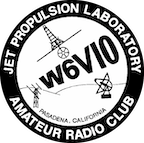The JPL Amateur Radio Club has four repeaters located around the Los Angeles Basin. In the mid 1970’s, we installed two 220 MHz repeaters. The club had originally wanted to install a 2-meter repeater but the coordinating body thought that 2-meters was “too crowded”, so they offered us two 220 MHz repeater channels. Not wanting to say no, the offer was accepted and the JPL ARC became a 220 club.
Since there was no such thing as a commercial repeater controller at that time, or at least they were few and far between, the controllers were home brew CMOS TTL on wire wrap boards and used R’s and C’s for all of the timer functions. Midland 13-509 radios were chopped apart to split the Rx and Tx sections and were modified for flat audio operation, MICOR squelch and audio delay lines on the Rx Input. Control was was via a special dial-up line. One of the repeaters was setup to accept audio from a standard broadcast audio loop that was used for Shuttle Audio transmissions. The other repeater had an autopatch. The autopatch repeater even had a digital clock circuit which would lock the autopatch down at night.
These repeaters were rock solid and provided over 25 years of service, and are still in use today. The author spent many a fine afternoon on the hilltop moving wire jumpers to change codes or add new functions.
After the Table Mountain repeaters were installed, it was thought that it would be nice to provide a link between one of the Los Angeles repeater and the TMO repeaters. Link frequencies were very hard to come by, so it was decided to do “in-band” linking. A special linking repeater was built that would scan between the outputs of the Los Angeles repeater and the TMO repeater. When it detected a valid signal on one of the repeater outputs, it would bring up the transmitter to the other repeaters input. By valid signal, our repeater encode CTCSS on the output only when there is a valid signal on the input of the repeater. The CTCSS encoders and decoders all use Reverse Phase Keying (RPK) which is a method of CTCSS boards signaling end of transmission without just waiting for the tone to go away. This allows turnaround times on the repeater to be on the order tens of milliseconds instead of hundreds. This is the same signaling we use for our IRLP link.
Flash forward to about eight years ago, we again tried to put up a 2-meter repeater. After a few fits and starts, we were allocated a 2-meter channel. We then went after a 440 channel. This was proving very hard to do since 90% of the repeater channels in Southern California were designated as being for private repeater use only and if you wanted to put up an open repeater, you had to share a channel with about a dozen other systems. Several years ago, Southern California broke ranks from the rest of the country and went to 20 kHz channel spacing instead of 25 kHz. This opened up a few more channels. Since some radios will not work with 20 kHz channels, it was decide to put the open repeaters on the frequencies which also match up with 25 kHz channel. The JPL ARC was one of the first systems to be awarded one of the new frequencies. So we now had a legal 440 repeater.
